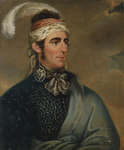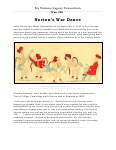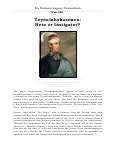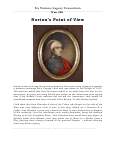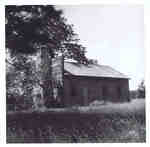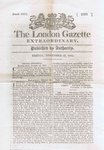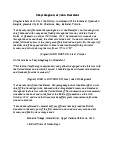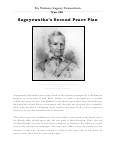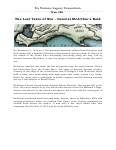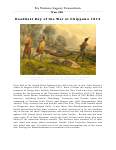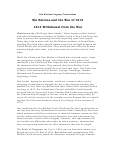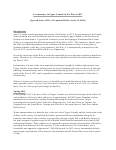Results




Page 1 of 1
- Image of Portrait of Major John Norton as Mohawk Chief Teyoninhokarawen, Oil on canvas. 30 x 25 in. by Mather Brown (1761-1831). The mixed blood son of a Cherokee father and Scottish mother, Norton wImage of Portrait of Major John Norton as Mohawk Chief Teyoninhokarawen, Oil …
- Image of Painting of John Norton (Teyoninhokarawen), portrait probably painted by Solomon Williams around 1804. The combination of Iroquois and Mohawk clothing worn by Norton in this portrait reflectImage of Painting of John Norton (Teyoninhokarawen), portrait probably painted by Solomon …
- Image of Portrait of Major John Norton as Mohawk Chief Teyoninhokarawen, Oil on canvas. 30 x 25 in. by Mather Brown (1761-1831). The mixed blood son of a Cherokee father and Scottish mother, Norton wImage of Portrait of Major John Norton as Mohawk Chief Teyoninhokarawen, Oil …
- Nineteenth in a 62 part series, Norton’s War Dance describes John Norton’s participation in a traditional native war dance.Nineteenth in a 62 part series, Norton’s War Dance describes John Norton’s …
- Twenty-Ninth in a 62 part series, Teyoninhokarawen - Hero or Instigator is a discourse on John Norton’s role in the War of 1812Twenty-Ninth in a 62 part series, Teyoninhokarawen - Hero or Instigator is …
- Forty-Fourth in a 62 part series, Norton’s Point of View is an excerpt from the journal of Major John Norton in which he offered the opinion that the American military treated its Native allies in aForty-Fourth in a 62 part series, Norton’s Point of View is an …
- This is a photo of Morgan Cabin that was owned by Lieutenant David Morgan. Chief (Major) John Norton was known to have visited this cabin in April 28, 1809; before becoming an important First NationsThis is a photo of Morgan Cabin that was owned by Lieutenant …
- The London Gazette issue that reports on the death of Isaac Brock at the Battle of Queenston Heights on 13 October 1812. The London Gazette, originally called The Oxford Gazette, was first publishedThe London Gazette issue that reports on the death of Isaac Brock …
- Correspondence between John Norton, John A. Hutchison and John Brant.Correspondence between John Norton, John A. Hutchison and John Brant.
- Forty-Eighth in a 62 part series, Sagoyewatha’s Second Peace Plan describes Red Jacket’s proposal to Buffalo Creek chiefs to withdraw from The War of 1812Forty-Eighth in a 62 part series, Sagoyewatha’s Second Peace Plan describes Red …
- Fifty-Ninth in a 62 part series, The Last Taste of War - General McArthur's Raid describes the November, 1814 battle led by General Duncan McArthur, which was one of the last major military assaultsFifty-Ninth in a 62 part series, The Last Taste of War - …
- Thirty-Sixth in a 62 part series, Deadliest Day of the War at Chippawa describes the deadliest day of the War of 1812Thirty-Sixth in a 62 part series, Deadliest Day of the War at …
- Describes the involvement of Red Jacket and the Buffalo Creek warriors in some of the final battles of the War of 1812.Describes the involvement of Red Jacket and the Buffalo Creek warriors in …
- Speech Notes for Daniel J. Glenney's presentation 'Freemasonry in Upper Canada in the War of 1812'. The speech provides a historical summary of the War of 1812, with a particular emphasis on the partSpeech Notes for Daniel J. Glenney's presentation 'Freemasonry in Upper Canada in …
- Describes the ten major themes of the War of 1812 which are particularly relevant to Six Nations communities. Researched by the Six Nations Legacy ConsortiumDescribes the ten major themes of the War of 1812 which are …
Page 1 of 1
When selecting an individual record or object, you will move
to the website of the heritage institution that houses the item.
To return to the search or results pages, select "Back", "Results" or "New Search".
 This project was made possible with the support of the Department of Canadian Heritage
This project was made possible with the support of the Department of Canadian Heritage
through the Canadian Culture Online Strategy.
to the website of the heritage institution that houses the item.
To return to the search or results pages, select "Back", "Results" or "New Search".
 This project was made possible with the support of the Department of Canadian Heritage
This project was made possible with the support of the Department of Canadian Heritage through the Canadian Culture Online Strategy.





